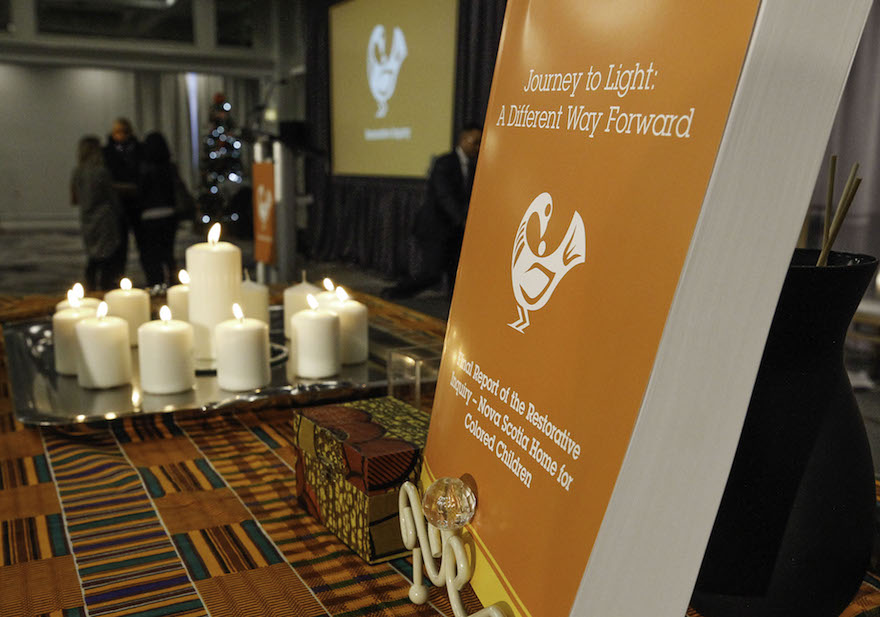Final Report of the Restorative Inquiry – Nova Scotia Home for Colored Children
The Nova Scotia Home for Colored Children Restorative Inquiry was established following a 17-year journey for justice by former residents of the Nova Scotia Home for Colored Children (NSHCC, or the Home). It was established under the authority of the Public Inquiries Act following a collaborative design process involving former residents, Government, and community members.
This public inquiry was the first of its kind in Canada to take a restorative approach. The Inquiry was a part of the Government of Nova Scotia’s commitment to respond to the institutional abuse and other failures of care experienced by former residents of the Nova Scotia Home for Colored Children.
In establishing the Restorative Inquiry, the Government of Nova Scotia recognized that the history, experience, and legacy of the Home reflects the systemic and institutionalized racism that has shaped Nova Scotia’s history and continues to impact the lives and experiences of African Nova Scotians to this day.
This is the Final Report of the Nova Scotia Home for Colored Children Restorative Inquiry. The tag line for the Inquiry is: A Different Way Forward. This report reflects that different way, in terms of both its content and its structure, and should be read and used in that light.
Download the full Report of the Restorative Inquiry – Nova Scotia Home for Colored Children (568 pages PDF - 7.4 MB)
Watch "Journey to Light: A Different Way Forward" – Hon. Stephen McNeil remarks on YouTube

The Council of Parties is the group of appointed commissioners who led the Restorative Inquiry. Front row, from left to right: Jennifer Llewellyn, Jean Flynn, Chief Judge Pam Williams and Deborah Emmerson. Back row, left to right: Michael Dull, Dean Smith, Wayn Hamilton, George Gray, Tony Smith and Gerald Morrison. The empty chair represents the late Joan Jones, a Council member and celebrated community activist who passed away in April 2019.
About the Report
The Final Report reflects the wisdom of Sankofa, which has served as a symbol for the work of the Inquiry. It stands for the idea that it is not taboo to go back and fetch that which you have forgotten. The Restorative Inquiry looked back, not to ascribe blame, but to shed light on the history and experience of the Home in order to learn from it and move forward into a brighter future. The Report reflects this commitment to look back and learn to make a difference for the future.
Download the report cover and table of contents (10 page PDF - 3.84 KB)
Chapter 1: The Nova Scotia Home for Colored Children Restorative Inquiry: A Different Way, A Different Report
Chapter 1 provides an overview of the purpose and structure of the Report. It explains how the restorative approach to Public Inquiry has produced a different Report that reflects how the Inquiry worked in a different way and to serve as a guide for the way ahead.
Download chapter 1 (16 pages PDF - 594 KB)
Chapter 2: The Restorative Inquiry: Mandate, Structure, Approach & Process
Chapter 2 details the restorative approach that shaped the Inquiry and distinguished it from traditional models of public inquiries. It describes the inquiry’s processes and operations, including their scope, breadth, and depth.
Download chapter 2 (61 pages PDF - 527 KB)
Chapter 3: The History of the Nova Scotia Home for Colored Children: Governance, Operations & Living Conditions
Chapter 3 provides an overview of the origins, history, operations, and the resulting living conditions and experiences of the residents of the Nova Scotia Home for Colored Children. More than a simple chronology or institutional history, the chapter is framed by a recognition of the importance of a range of institutional relationships that governed the nature and operations of the Home. It examines the facts, context, conditions, and circumstances that are most significant to understanding its history.
Download chapter 3 (111 pages PDF - 2.6 MB)
Chapter 4: The Journey to Light and the Road to the Restorative Inquiry
Chapter 4 traces the former residents’ journey to light, from the first revelations about the harms and abuses they experienced as young people at the Home through to the establishment of this Restorative Inquiry. The chapter details the responses to their institutional abuse (and failures of care) by Government, the Nova Scotia Home for Colored Children, and by some within the African Nova Scotian community.
Download chapter 4 (61 pages PDF - 1.6 MB)
Chapter 5: Understanding the History, Context and Experience of the Nova Scotia Home for Colored Children
Chapter 5 provides an analysis of the history and experience of the Nova Scotia Home for Colored Children and the former residents’ efforts to get a response to the institutional abuse and failures of care they experienced at the Home and the systemic racism that shaped the institution and former residents’ experiences.
Download chapter 5 (115 pages PDF - 664 KB)
Chapter 6: The Way Forward: What We Have Come to Learn and Understand
Chapter 6 examines what we came to learn and understand from the history and experience of the Home and its implications for the way forward on the central issues of responding to institutional abuse (failures of care), experience of care/system of care, and systemic racism. Chapter 6 shares the learning (background information, evidence, and other resources) gathered through this process and ensures it is available to support the parties’ work going forward.
Download chapter 6 (105 pages PDF - 1.6 MB)
Chapter 7: Making a Difference: Actions, Plans, Commitments and Recommendations
Chapter 7 shares the actions, plans, commitments, and recommendations that emerged through the Inquiry process as steps towards a fundamental shift in support of a different way forward. It reflects the elements of the work ahead to support parties’ plans and commitments. This chapter will provide an important guide for next steps to make a difference for children, young people, families, and communities in Nova Scotia.
Download chapter 7 (66 pages PDF - 3.64 KB)
Afterword and Forward, Appendices
Download the Afterword and Forward, Appendices (17 pages PDF - 197 KB)

Restorative Inquiry co-chairs Tony Smith, left, and Chief Judge Pamela Williams take part in the closing ceremony of the Restorative Inquiry on November 28, 2019.
Five Part Video Series
Part 1: The Nova Scotia Home for Colored Children A Brief History
Part 2: The Journey
Part 3: What is a Restorative Inquiry
Part 4: Experiencing The Restorative Process
Part 5: What Difference Did it Make?
Summary notes
- Final Report Overview (PDF - 210KB)
- A Restorative Approach to Inquiry (PDF - 132KB)
- History and Context (PDF - 521KB)
- The Need for a Shift (PDF-230KB)
- Planning and Action (PDF - 115KB)

The Restorative Inquiry Council of Parties presented its final report at a closing ceremony on November 28, 2019.